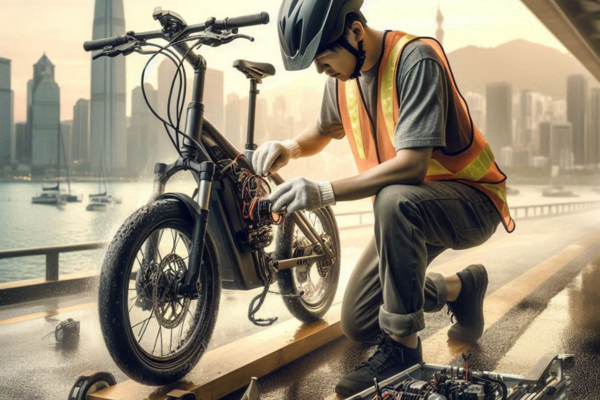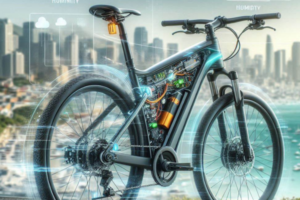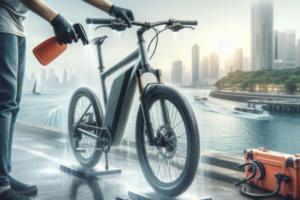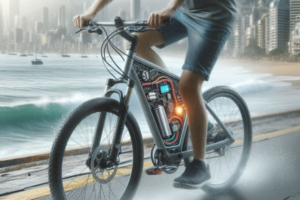Protection and Energy Savings: Maintenance in Humid Climates for Electric Bicycles
🌧️ Why Humid Climates Demand Specialized E-Bike Care
If you live in a coastal or tropical city, you already know how moisture affects everything — from the shine of your windows to the smell of your wardrobe. But few riders realize just how dramatically humidity impacts the performance and energy consumption of their electric bicycles. Water vapor in the air doesn’t just create condensation on your frame; it infiltrates moving parts, accelerates corrosion, and puts extra load on your motor. Over time, this leads to faster battery drain, noisier rides, and higher maintenance costs.
In places like Miami, Cartagena, or Manila, where humidity regularly exceeds 70%, electric bikes face a perfect storm of environmental stress. Salt particles from sea air mix with moisture to form a layer of invisible residue that clings to chains, brakes, gear systems, and electrical connectors. Even if you’re not riding in the rain, your bike is still exposed to an environment that demands a tailored approach to protection and upkeep.
The good news? With simple yet consistent practices, you can turn the challenge of humidity into an opportunity for smarter, more efficient riding. This article explores the best methods to protect your e-bike and maximize energy savings — from materials and coatings to riding habits and weekly routines.
🔍 The Link Between Maintenance and Energy Efficiency
One of the most misunderstood aspects of e-bike ownership is how energy efficiency is directly tied to maintenance. A clean and well-lubricated chain, properly inflated tires, and protected battery terminals all contribute to smoother motion. In contrast, rusty drivetrains and compromised electrical components create drag, resistance, and inefficiency — which the motor must overcome by using more power.
Every watt your motor spends fighting friction is a watt that could have extended your range. And in humid environments, friction builds faster than you may think. That’s why protective maintenance isn’t just about longevity — it’s about making sure your e-bike uses energy wisely, every time you ride.
💭 Inspirational Insight
“An e-bike maintained for protection isn’t just stronger — it’s smarter, quieter, and far more efficient with every mile.”
As more people switch to electric bikes for commuting and recreation, especially in cities impacted by climate change, the importance of climate-aware care becomes essential. Protection is no longer optional — it’s the gateway to performance, sustainability, and peace of mind.
🧰 Essential Protective Maintenance Checklist for Humid Climates
To keep your electric bicycle performing optimally in humid regions, protection must become part of your regular routine. Moisture is sneaky — it seeps into bolt threads, hides behind brake pads, and condenses inside battery ports. That’s why prevention, not just correction, is key to saving energy and extending your bike’s lifespan.
Use the following checklist to create a weekly or bi-weekly maintenance ritual that keeps your ride clean, efficient, and protected against the invisible wear of humidity:
- 🧼 Wipe down the frame and motor housing after every ride to remove moisture, salt residue, and dust.
- 🔧 Inspect all exposed bolts and connectors for signs of rust or oxidation. Apply a light protective lubricant if needed.
- 🛢️ Lubricate the chain using a wet-condition lubricant specifically designed for humid climates.
- 🛡️ Use frame protectants or ceramic coatings to add a water-repelling barrier to your e-bike’s surface.
- 💨 Clean brake pads and rotors using alcohol wipes or brake-specific cleaners to avoid drag and slippage caused by humidity.
- 🔋 Dry and inspect battery contacts weekly. Avoid water pooling around the power switch or display ports.
- 📏 Check tire pressure regularly, as humidity-related temperature fluctuations may cause subtle pressure loss.
By sticking to this routine, your e-bike will operate more smoothly and efficiently — which directly translates to less battery drain and a better ride experience. Every bit of resistance you eliminate gives your motor more room to operate efficiently, and your battery more time before the next charge.
📊 Comparing Protective Materials and Coatings
If you’re planning to upgrade your components or invest in better protection, it’s worth comparing the effectiveness of different materials and coatings. Not all protections are created equal — and some may cost more upfront, but save energy and money in the long run.
| Protection Type | Humidity Resistance | Energy Efficiency Benefit | Recommended Use |
|---|---|---|---|
| Wet-condition chain lubricant | High | Reduces friction and motor strain | Weekly maintenance |
| Dielectric grease | Very High | Prevents electrical inefficiency | Battery and motor terminals |
| Ceramic frame coating | Moderate–High | Keeps frame surfaces smooth | Initial investment |
| Stainless steel bolts | High | Avoids long-term rust buildup | Custom upgrades |
Choosing the right protective elements not only improves durability, but also reduces the need for your motor to overcompensate. The result? A smoother ride and a stronger battery — even in the most humid conditions.
🌦️ Real-World Story: Learning from a Humid Commute
Carlos, a delivery rider in Cebu City, Philippines, began noticing that his e-bike was losing range faster than usual. Although he followed a basic maintenance routine, he often parked his bike outside during his workday. After three months, his brake rotors were rusted, the chain sounded rough, and his battery range had dropped by nearly 20%.
He sought advice from a local e-bike technician who introduced him to a new weekly ritual: drying and re-lubricating all moving parts, cleaning his battery ports with a dry cloth, and applying ceramic protectant to the frame. Within a few weeks, his range began improving, and he reported smoother acceleration and a quieter ride.
Carlos’s case is a reminder that even short-term exposure to high humidity — without adequate protection — can reduce your e-bike’s performance. But with intentional habits, recovery is possible and energy savings return quickly.
🌀 The Energy Cost of Overexposure
When your e-bike sits unprotected in a humid environment — even if it doesn’t rain — moisture settles into micro-spaces: inside your headset, around the crank arms, between gear teeth, and along the brake pads. As this builds up, your motor begins working harder to compensate for subtle friction and resistance that the eye can’t always detect.
You may still reach your destination, but you’ll consume more battery to get there. Over time, this means more frequent charging, reduced battery health, and increased costs — not to mention unnecessary wear on your components.
Tip: If your e-bike has a range display, monitor how your distance per charge changes before and after applying proper protection routines. Even a 5–10% improvement can save dozens of full charges each year.
🏘️ Outdoor vs. Indoor Storage: The Hidden Difference
One of the most powerful ways to protect your e-bike — especially in humid cities — is simply storing it correctly. Outdoor storage exposes your bike to temperature fluctuations, dew, salt particles, and airborne moisture that slowly degrade metal and electrical parts, even if it’s under a waterproof cover.
In contrast, indoor storage (in a ventilated room, covered garage, or dry shed) maintains stable conditions that prevent condensation. While not everyone has indoor access, even storing your bike under an awning with airflow or placing moisture absorbers inside a covered enclosure can make a meaningful difference.
Battery components are especially sensitive to moisture. Leaving your battery attached during high humidity nights or right after a rainy ride can shorten its lifespan over time. Always allow your battery to cool and dry before charging, and unplug the charger from the outlet when not in use.
🔋 Battery Protection in Humid Conditions
Your battery is the most valuable and sensitive component of your electric bicycle. In humid climates, moisture can cause subtle but serious damage — especially if it infiltrates charging ports, connectors, or internal circuits. Over time, this can lead to voltage drops, reduced range, and even premature failure.
Fortunately, battery degradation due to humidity is preventable with the right care habits. Whether you ride daily or just a few times a week, these protective steps can make a measurable difference in energy efficiency and lifespan.
🧰 Best Practices for Battery Health in Humid Environments
- ☁️ Let the battery breathe: After every ride, allow the battery to cool and dry before charging — especially if exposed to moisture or heat.
- 🔌 Use manufacturer-approved chargers: They regulate energy flow better and are less likely to create condensation inside the port during charging.
- 🛡️ Keep charging ports covered: When not in use, close the rubber seal or protective flap to prevent dust and moisture buildup.
- 🏠 Store indoors between 15°C and 25°C: Avoid garages or sheds that trap humidity, and never leave the battery near open windows or vents.
- 🧽 Gently clean battery contacts with a dry cloth; avoid water or sprays unless specifically recommended by the manufacturer.
Following these simple routines ensures that your battery delivers consistent power and reduces the risk of wasted energy due to corrosion or internal resistance. Remember: protection today is prevention tomorrow.
💡 Common Misconceptions About E-Bike Protection
Even experienced riders sometimes rely on habits that unintentionally harm their electric bicycles — especially when it comes to moisture and energy use. Let’s clarify some common myths:
- ❌ “Water-resistant means waterproof.” While your e-bike may be water-resistant, that doesn’t mean it’s immune to long-term humidity exposure. Protection is still necessary.
- ❌ “Covers eliminate all risk.” Many plastic or vinyl bike covers actually trap moisture underneath. Ventilation is key for protection, not just shielding.
- ❌ “Energy drops are always battery faults.” In reality, energy loss often comes from increased resistance caused by rust, dirt, or friction — not battery age.
Being aware of these misconceptions helps you make smarter decisions and avoid expensive mistakes. Every choice — from where you park to how you charge — impacts your bike’s efficiency and protection.
Tip: Make it a habit to inspect your battery and charging port at least once a week, even if you haven’t ridden. Humidity can creep in quietly, especially during the night.
❓ Frequently Asked Questions (FAQs)
Is riding an e-bike in a humid climate bad for the battery?
Not necessarily — as long as you protect the battery properly. Store it indoors, avoid charging it while wet or hot, and always keep charging ports clean and sealed. These habits will prevent long-term issues and preserve energy efficiency.
Can I spray my e-bike with water after a humid ride?
Avoid using a hose or high-pressure spray. Instead, use a damp cloth to wipe down the frame and a dry brush for hard-to-reach areas. Excess water can seep into sensitive parts and create hidden moisture buildup.
What’s the best lubricant for coastal or humid environments?
Choose a wet-condition or marine-grade chain lubricant that repels water and resists salt corrosion. These products are specifically designed to perform in high-humidity situations and reduce drivetrain friction.
How can I tell if humidity is affecting my energy usage?
If your range drops despite normal usage, or your motor seems louder or slower, humidity may be increasing resistance in your system. Look for signs like rusty bolts, dirty chains, or brake drag — all of which force the motor to work harder.
💬 Final Thoughts
Electric bicycles are powerful, eco-friendly tools for transportation and lifestyle. But in humid climates, they require a little extra care to perform at their best. By developing a simple, consistent protection routine, you not only safeguard your investment — you also ride smarter and farther with every charge.
Energy savings and performance aren’t just about the motor or battery specs. They’re about how your entire system — frame, chain, tires, brakes, electronics — work together in harmony, free from unnecessary resistance.
So whether you live in a coastal city, a tropical forest, or a rainy mountain town, remember this: Protection isn’t just about avoiding damage — it’s the foundation of efficient, joyful, and confident riding.
How do you protect your e-bike in a humid climate? Share your go-to tips, favorite tools, or lessons learned in the comments — your advice might inspire someone else to ride better and protect smarter.



